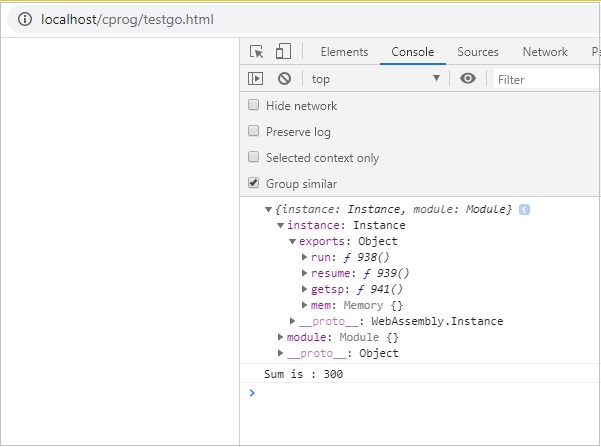
- WebAssembly - Home
- WebAssembly - Overview
- WebAssembly - Introduction
- WebAssembly - WASM
- WebAssembly - Installation
- WebAssembly - Tools to Compile to WASM
- WebAssembly - Program Structure
- WebAssembly - Javascript
- WebAssembly - Javascript API
- WebAssembly - Debugging WASM in Firefox
- WebAssembly - “Hello World”
- WebAssembly - Modules
- WebAssembly - Validation
- WebAssembly - Text Format
- WebAssembly - Convert WAT to WASM
- WebAssembly - Dynamic Linking
- WebAssembly - Security
- WebAssembly - Working with C
- WebAssembly - Working with C++
- WebAssembly - Working with Rust
- WebAssembly - Working with Go
- WebAssembly - Working with Nodejs
- WebAssembly - Examples
- WebAssembly Useful Resources
- WebAssembly - Quick Guide
- WebAssembly - Useful Resources
- WebAssembly - Discussion
WebAssembly - Working with Go
Go has added support for WebAssembly from version 1.1 onwards. To test it first download, Go.
Go to the golang site, which is available at https://go.dev/dl/ and click on Download Go. As per your operating system download and install Go.
Once done, write a simple program that adds two numbers in go.
testnum.go
package main
import "fmt"
func main() {
var a int = 100
var b int = 200
var ret int
ret = sum(a, b)
fmt.Printf( "Sum is : %d\n", ret )
}
/* function returning the max between two numbers */
func sum(num1, num2 int) int {
return num1+num2
}
To compile above code to wasm, first set the environment variables in Go.
You will have to run following command −
Set GOOS=js GOARCH=wasm
Once done, execute the below command −
go build -o testnum.wasm testnum.go
You should get testnum.wasm file once the command is executed.
Let us now test the code in the browser. To do that, we need to get the wasm_exec.js, that is installed with go.
The file wasm_exec.js will be available inside misc/wasm/ folder in go.
Example
Here, is the code for testgo.html that makes use of wasm_exec.js and testnum.wasm.
<html>
<head>
<meta charset="utf-8"/>
<script src="wasm_exec.js"></script>
</head>
<body>
<script type="text/javascript">
const importObj = {
module: {}
};
const go = new Go();
async function fetchAndInstantiate() {
const response = await fetch("testnum.wasm");
const buffer = await response.arrayBuffer();
const obj = await WebAssembly.instantiate(buffer, go.importObject);
console.log(obj);
go.run(obj.instance);
}
fetchAndInstantiate();
</script>
</body>
</html>
Output
The output is as follows −
